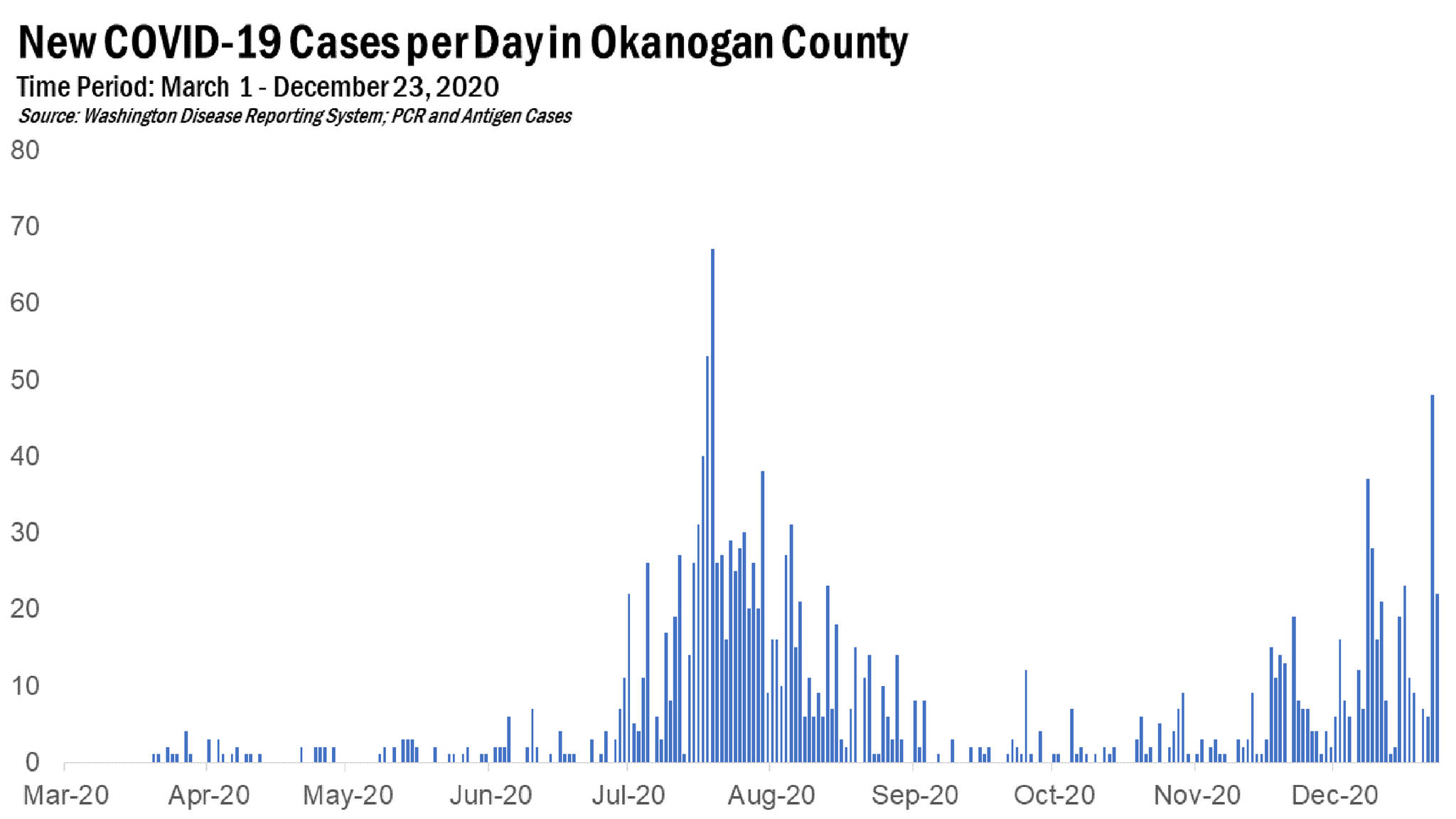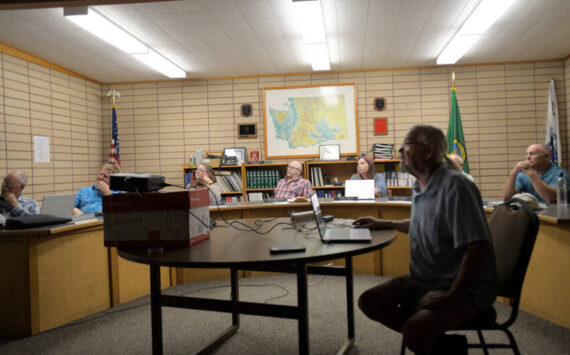OKANOGAN – The 14-day COVID-19 Incidence Rate for Okanogan County dipped slightly in the past two weeks, according to last Monday’s data report from Okanogan County Public Health.
The 14-day incident report for the county is now 386.2 per 100,000 people, according to the agency. That’s nearly 54 less than the previous week’s 14-day incident rate of 440 per 100,000.
Public Health reports there were 17 new cases over the four-day period between Dec. 24 and Dec. 27, according to the COVID-19 Data Report released by the agency Dec. 28. Most of the cases, 11, were discovered on Christmas eve, Dec. 24. Of the 17 cases over the four-day period, six were from Oroville; three from Winthrop; two each in Okanogan, Omak and Tonasket and one in Twisp.
The cumulative total since testing began in March is 1693, up 104 from last week. The number of deaths from the virus remains at 32.
According to Public Health, Brewster has had a total of 653 people (up five from their previous report) who have tested positive for the virus since testing began in the county. The next highest is Omak, with 308 (up 22); Tonasket, 204 (up 27); Oroville, 144 129 (up 15); Okanogan, 132 (up 18); Pateros, 54 (up two); Nespelem, 39; Twisp, 31 (up one); Malott, 31 (up two); Coulee Dam, 27 (up two); Winthrop, 21 (up four); Riverside, 15 (up two); Loomis, nine; Elmer City, eight; Carlton, eight; “unidentified,” five and Conconully and Mazama, one each.
Countywide, males have returned the most positive tests, with a total of 855, and 10 deaths, while females have had 756 total positive tests and five deaths. However, 82 people are recorded in the “unknown” category as far as gender, with 17 deaths, as of last Monday.
Statewide
The Washington State Department of Health (DOH) released the latest statewide situation report on COVID-19 on Thursday, Dec. 24. The report shows substantial decreases in transmission that are still not enough to return the state to the lower levels of disease activity seen earlier in the fall. Based on the timing of this trend, the plateaus may be due in part to the current restrictions on gatherings and certain businesses, according to the DOH.
Report findings include: The state remains in a highly precarious situation. The estimated proportion of the population with active COVID-19 infections is around the same as mid-November and hospitalizations are higher. The DOH says if behaviors that lowered transmission over the past month aren’t maintained, the state could see exponential growth again—this time starting from a much higher baseline.
COVID-19 transmission is plateauing, but hasn’t decreased enough, according to the agency. The best estimate of the reproductive number (how many new people each COVID-19 patient will infect) on Dec. 5 was 1.03 in Western Washington and 1.11 in Eastern Washington. The goal is maintaining a reproductive number well below one—meaning COVID-19 transmission is declining—for a substantial amount of time.
Thirty-one of 39 counties had rates above 200 new cases per 100,000 people over the past two weeks. Sixteen counties had two-week rates above 500 new cases per 100,000 people. This indicates COVID-19 activity is still high and widespread in the state.
Cases and hospitalizations started to plateau just before Thanksgiving, then rebounded again after the holiday. This drop was likely due to fewer people seeking care or getting tested over Thanksgiving, rather than an actual decrease in COVID-19 activity, according to DOH. There have been some declines in cases statewide and in hospitalizations in Western Washington since then. Hospitalizations in Eastern Washington have remained level.
Daily hospital admissions of patients with confirmed COVID-19 have been relatively flat statewide since early December. Admissions increased gradually through Oct. 31, accelerated through Nov. 23, briefly dropped over the week of Thanksgiving, then rebounded until early December. The Department of Health expects high hospital occupancy to last beyond drops in admission since COVID-19 patients generally stay in the hospital longer than one day.
Despite some hints of progress, hospitals and intensive care units (ICUs) remain stressed. In Western Washington, the number of hospital beds occupied by COVID-19 patients increased rapidly in early November then slowed in early December. In Eastern Washington, increases were slower but have continued through mid-December. The number of ICU beds occupied by these patients plateaued in Western Washington at the start of December then dropped in mid-December, and have remained flat throughout December in Eastern Washington.
Some counties are seeing declining case counts. The five largest counties (Clark, King, Pierce, Snohomish and Spokane) have seen recent declines in case counts. Some medium-sized counties (Franklin, Thurston and Whatcom) and small counties (Chelan, Kittitas, Stevens, Whitman) had recent declines to mid-November levels.
Other counties are plateauing. Some mid-sized counties (Benton and Cowlitz) and some small counties (Douglas, Okanogan and Walla Walla) have seen flattening to pre-Thanksgiving levels. Other mid-sized counties (Grant, Kitsap, Skagit and Yakima) and small counties (Grays Harbor, Lewis and Mason) have seen flat or declining trends, but still have higher case counts than before Thanksgiving.
The estimated overall percentage of Washington state residents with active COVID-19 infection was still higher than the peak in late March. The best model-based estimate as of Dec. 5 was 0.41 percent. Prevalence estimates started to flatten in mid-November, but remain several times higher than at the start of October.
“Because of the high levels of disease activity Washington state has seen this fall, we are looking for more than just a flat trend. We need to see a significant decrease in cases and hospitalizations, and the only way to get there is to intensify our current efforts to control the spread of the virus,” said Dr. Umair A. Shah, secretary of health at DOH. “It is encouraging to see that those efforts have helped the state avoid a post-Thanksgiving spike. If we want to maintain this progress going into the new year, we must take every precaution possible including limiting in-person celebrations to our immediate households.”
DOH partners with the Institute for Disease Modeling, Fred Hutchinson Cancer Research Center, University of Washington and the Microsoft AI for Health program to develop these reports every other week. More COVID-19 data can be found on the DOH data dashboard and in the state’s risk assessment dashboard.






